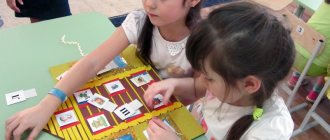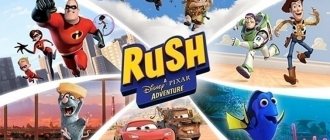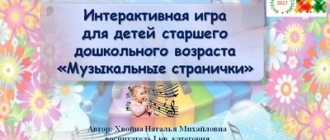Definition of didactics
The word “didactics” is translated from ancient Greek as “educational”. So, when children are taught in an informal play atmosphere, when the child “learns while playing,” experiencing pleasure from the process, this is both a lesson and a game, a didactic game.
A child’s imaginative thinking is directly related to the fact that a little person learns about the world in a playful way.
If you and your child spent the weekend at the zoo, and he was impressed by the orangutan Buba, then get ready for the next few days that all family members will participate in a game called “Buba in the Zoo”.
Imaginative thinking helps a child feel the beauty of the world around him, believe in fairy tales, and develops imagination and creative abilities.
A game for a preschooler is a way of life. And if the game is given an educational focus, then one hundred percent mastery of the material is guaranteed. This is why the didactic game for speech development is so actively used when working with children.
Purpose of the game
Didactic games develop in a child:
- Cognitive skills. The child observes, learns a lot of new things, expands existing knowledge about the world around him, living and inanimate nature.
- Mental capacity. A person learns to think, express his thoughts, construct sentences, reason. And also - remember, compare, evaluate.
- Speech. The vocabulary increases significantly, pronunciation improves, the ability to participate in dialogues and pronounce monologues is formed.
- Moral qualities. The child learns to help, sympathize, restrain himself, and respect others.
- Social adaptation. Skills are acquired such as the ability to conflict, participate in competition, interact with peers, adults, give in to others, and not be offended.
Therefore, if your baby has been asking you to play with him for half an hour, and you have absolutely no time for this, give him a jar of semolina with beans hidden in it, and ask him to prepare dinner for the zoo pets. While you are cooking borscht for dad)).
Types and examples of didactic games for preschoolers
Didactic games differ in content, actions, rules and come in three types:
- games with objects;
- printed board games;
- verbal didactic games.
Their degree of difficulty can be adjusted depending on the age of the participants. The same game can have several variants. For example, kids arrange cards by color; Older children name numbers; and someone can already put the word together.
Games with objects
1. Magic bag
You need to pull out objects of different shapes by touch from the bag: a ball, a cube, a pyramid. Or objects with different textures: pine cone, acorn, chestnut.
2. Rainbow
The child is invited to arrange cubes, mosaics, and pyramids by color.
During didactic games with objects, the child learns to think, analyze, compare objects with each other, he becomes more attentive, his horizons expand, and his fine motor skills improve.
Board-printed games
There is a huge scope for choosing what will be most interesting to your baby at a given time. It can be:
- Pictures for recognition in the form of images, shadows, contours.
- Puzzles.
- Lotto.
- Pictures: find the differences.
- Pictures: pick a pair.
- Labyrinths.
- Designers.
Such didactic games for preschoolers on speech development are interesting and educational. They successfully develop speech skills, logic and imagination, and develop perseverance and patience.
Word games
This type of cognitive communication is very relevant when there are no special objects at hand, so you can use the most familiar things. Here are some examples of such didactic games for the development of speech in preschoolers.
1. Doll
Description of the appearance: color of hair, eyes, clothing items of the fashionable doll.
2. Who is missing?
Place several soft toys nearby. Ask them to close their eyes and remove one. Who can guess: who is missing? We need to name it, tell it what it looks like, figure out where it ran away to.
3. Cube
They roll a dice with pictures on each side. You need to name what is depicted on the top edge and imitate the sound of the object. For example, a steam locomotive. How does the locomotive sound?
4. Catch the ball - name the word that has the opposite meaning. Hot-cold, big-small, close-far.
Verbal games for preschoolers develop speech, reaction speed, correct pronunciation of sounds, expand vocabulary, teach how to construct sentences correctly, and express their thoughts coherently.
methodological manual “Speech - cubes”
| Author: Pisarevskaya Polina Sergeevna, Teacher speech therapist MBDOU "Child Development Center - g - kindergarten No. 15 “Wonderland” Khanty-Mansiysk |
Introduction
Didactic manual “Speech-cubes” for the correction of lexical and grammatical categories and related speech in children of senior preschool age. The use of game techniques when correcting speech with the help of a manual allows you to develop phrasal speech, master the construction of complex sentences, enrich your vocabulary (expressive speech), master the skills of word formation and inflection with the help of exercises and homework
The content of corrective work in accordance with the requirements of the Federal State of Preschool Education (hereinafter referred to as FGT) is aimed at creating a system of comprehensive assistance to children in mastering the basic educational program of preschool education, correction of disabilities and (o) mental development of schoolchildren, their social adaptation and provision of qualified assistance to children disabled people One of the priority tasks of older preschoolers is preparing children for school. One of the main indicators of a child’s readiness for successful learning is correct and developed speech. Good language is the most important condition for the full development of children. The richer and more correct a child’s speech, the easier it is for him to express his thoughts, the wider his opportunities for acquaintance with the surrounding reality, the more meaningful and complete relationships with peers and adults, the more active his mental development is. Therefore, it is so important to take care of the timely formation of children’s speech, its purity and correctness, preventing and correcting various violations that are considered deviations from the generally accepted norms of a given language.
Speech therapy, as a science, allows you to study speech disorders, prevent and overcome them in the process of raising and teaching a child directly in educational activities and play. For children who have problems with lexico-grammatical forms and related expressions, these are, as a rule, children from the group of general language underdevelopment. The manual preserves the meaning and role of play activities in preschool age and timely language correction, as a necessary condition for the comprehensive development of personality, communication culture and intelligence. Systematization of didactic games according to the manual helps to overcome language deficiencies and teaches to speak correctly and competently.
The purpose of the textbook “Speech - Cubes” is the development of lexical and grammatical categories and related speech in children of senior preschool age.
The objectives of the manual are revealed through games and exercises, both in fragments of direct educational activity and in individual work as a moment of surprise.
- Attracting interest, creating motivation for a child’s interaction with the language process: the “Mood” game.
- Development of skills through tactile sensations, word-symbol and object associations: playing with the “Sensory” cube.”
- Formation of the ability to coordinate a noun with adjectives, the game “Color the Picture”; possessive adjectives and the development of ideas about the world around us: a “lost” game.”
- Master the agreement of names with cardinal numbers in gender, number, and case. Game "Konta".
- Consolidating word formation skills, activating vocabulary, expanding ideas about the world around us. Game “Little Boy”.
- Consolidation of pronoun and noun in agreement, repetition of lexical arguments. "Greedy" game.
- Consolidation of the dictionary on a lexical topic. For example, the game "Seasons".
- Development of visual gnosis. Find a picture game
- Learn to fly an airplane; in space. Game "Catch a fly".
- Formation of skills in selecting antonyms: words - signs, words - actions. Game "On the contrary".
- Teaching the ability to compose a descriptive story using TRIZ technology in pedagogy. Games “Descriptive story”, “Write”
- Consolidation of the use of prepositions as part of sentences, related speech [1]
Tutorial series:
Box …… .. ……………………… .. …….…. 1 PC.,
Cubes……………………………………. …… 6 pcs.,
Card index………………………………….. 8 pcs.,
Images for tasks ………………………… 30 pcs.
From history to reality
Creation of a teaching aid as a need to involve the child in the process of language correction, by changing the visual material. From a plate - a book, postcards, pictures, etc. to a three-dimensional object - for example, a cube. The wooden reading blocks that I saw in the store gave me the idea of using the cube as an option for correcting a child’s speech to help with proprietary speech therapy. For example, the logo technology of S.V. Konovalenko; E.O. Astafieva; O.S. Gomziak; THERE. Komarov; E.N. Spivak; T.A. Tkachenko at the stage of sound automation and correction of lexical and grammatical categories of speech. The simple and perfect shape of a cube is embodied in the Speech Cube teaching aid made from cellulose material, mica and other waste and office supplies.
The work has begun... The “Speech - Cube” manual is a series of six cubes measuring 7.5 / 7.5 cm. Drawing the sides of cubes, both permanent and with replaceable images, images. Cards with pictures can be used for game tasks and exercises. The combination of tasks is aimed at the formation of lexical and grammatical categories (formation and bending of words) and the development of coherent speech not in the form of individual sentences, but statements, descriptions, and reasoning. If we directly consider the purpose of each cube, its multifunctionality is reduced to a minimum, then the instructions are presented in a comprehensive manner, which makes it possible to fully conduct the correctional and educational process. The use of methods from the theory of inventive problem solving (TRIZ) in pedagogy makes it possible in practice to develop students’ coherent speech in games using developed diagrams and card symbols. Each symbol can be used in combination to assign exercises to other games. The essence of this method is that the child does not receive knowledge in a ready-made form, but during the game, through knowledge of only the symbol, he searches for a pattern that also meets the basic requirements of FGT. The principle of constructing lexical and grammatical categories of teaching linked speech according to the Speech-Cube manual from simple to complex with the use of both speech therapy technologies and psychological techniques to improve the quality of training and education. [3] app.docx (1.46 MB)
You can't teach a person to be happy
But you can teach him to be happy.
Makarenko A.S.
THE PRACTICE OF USING THIS INSTRUMENT “RECUBIC” SHOWS that the child is not distracted by the game lesson, but, on the contrary, is involved in the game. Focus your attention and interest on the exercise or task, choosing the answer yourself, fantasizing, thinking. The advantage is also good because children of any age can play it (the difficulty level of the tasks must correspond to the child’s speech skills) both individually and in a front-to-back classroom. [4]
Option 1. The child stands in the center of the circle with his eyes closed and holds a cube in his hand. Children walk in a circle saying:
One two three four five
Let's spin the cube!
Option 2. Children stand in a circle. The cube is moved along the chain, pronouncing any familiar rhyme. The child on whom the cube has settled chooses a face at will based on the task.
Option 3: The leading child walks in a circle and says a nursery rhyme. The child, by whom the count is being made, takes the cube, closes his eyes, rotates it, stopping on any face of the cube. The task is completed by yourself or all children together.
The concept of relevance, the child’s interest in a certain point in time forces us to search and create multifunctional and creative means that implement the tasks of the corrective educational process of learning and development of children in accordance with the requirements of the federal state of preschool education [5]
Game "Mood"
Competitive preparation
Task: to depict the hero’s mood on the fallen edge of the cube, to talk about the feelings that the hero experiences - feelings of empathy through facial expressions.
Task: transfer the facial expression of the fallen hero to the edge of the cube.
Playing with facial images of different moods allows for mini-diagnosis of problem areas and areas that require correction for further interaction within the team. Such diagnoses are often much more accurate and effective over time than diagnoses made using various tests and questionnaires. This training relieves tension between strangers by showing not what a person is thinking, but what facial expressions they are using. Plus, learning to interact while playing is safe, effective, and just plain fun and enjoyable.
Equipment: a cube with pockets on the edges, images of children's faces. [6]
Games for learning and declension of adjectives from nouns.
“Painting color”
Task: match the noun with relative adjectives
Task: Place blank image stencils along the colored edges of the cube and name the color image of the object. For example, red tomato, blue sky, golden square. Now let's complicate the task a little. Rotate the cube to match the counter ringtone and select the color of the cube's face. Task: name red fruits and vegetables or an object of any other color that falls on the upper part of the face (apple, pomegranate, radish, beet, tomato - red. Clouds - blue...) Well done!
Equipment: cube with colored borders, images with blank images [7]
Lost
Goal: to agree a possessive adjective with a noun.
Scene images with single elements of objects are used, parts of animals are used using two cubes with removable edges.
- Task: from the images on the faces of one cube, take the missing details on the faces of another. For example: whose turn is it? – fox tail, attach the fox tail to the image of the fox. Whose is it spinning? – car, replace the wheel with a picture of a car. Whose ears are these? – bunny ears, attach the ears to the image of the hare’s head.
- Task: a selection of images to identify trees and their leaves.
The version of the game can be organized according to the type of development: where the conversation continues with questions about the result of choosing a tree - leaf, for example: the name of the tree, the shape of the leaves, where it grows, if it changes color in the fall, etc.
Equipment: two cubes with pocket sides, pictures for the task. [8]
Word games
"Vice versa"
Goal: To develop the ability to select antonym words
The task of the game is performed on one cube and with the involvement of a second one, which is filled along the edges with antonym words highlighted.
Assignment: selecting words, antonyms for words - actions. For example: opens - closes, pours - pours, puts on - takes off, etc.;
– selection of antonyms for postcards according to schemes: what color? (black and white); what do we hear? (hot cold); What size? (big small); what do we hear? (in a quiet voice - in a loud voice); what do we see? (day - night) what does it taste like? (sour – sweet);
– selection of antonyms for the word – sign: wide – narrow, tied – loose, high – low, big – small
Equipment: two cubes with a point, pictures for the task. [nine]
“Scullion”
Objective: to consolidate word formation skills, activate vocabulary, expand ideas about the world around us.
Place images along the edges of the cube: beets, tomatoes, peach, apple, carrots, pear.
Task: determine what you can use to make juice or compote, then form adjectives from the noun, naming the juice or compote. Which would be superfluous for compote. Separate the concept of juice and compote. Equipment: cube with pockets, pictures with vegetables and fruits. [10]
"Greedy"
Task: agreement of pronouns with nouns, repetition of lexical arguments
An exercise to consolidate pronouns and nouns into agreement. Images are used on general topics: clothes, toys, fruits, etc. are located on the sides of the cube. Scrolling identifies the question by the image on the top edge of the cube. For example: whose topic..? - my; whose clothes are these..? - Maybe; whose toys? - my
Equipment: cube with pockets, images of clothes, shoes, toys...
Games on the chord and declension of a noun with a pronoun, with a numerator
"Count"
Task: to master the coordination of names with quantitative numbers in gender, number, case.
For counting, a cube with Arabic numerals and drums with images are used.
Task: an image with a selected number of objects in the image (the number on the face) is placed on each face to match the name with the numerator in gender, number, case. Very easy to play. The child, looking at the top edge of the cube, says: “I have two carrots.” Then he turns it over to the other side and passes it to the next one with the words “What about you?” - “I have five apples.”
Equipment: a cube with fixed edges depicting numbers, attaching a picture depicting numbers. [eleven]
Time orientation game on an airplane; in space.
“Catch a fly!”
Goal: learn to navigate an airplane; in space.
Spatial referencing problem. Ability to navigate on an airplane: image, sheet of paper with an image; paragraph; in space, consolidation of concepts at the top, bottom, right, left, center. Activity is determined by the direction of fall of the arrow or center position. The reference point (designation) depends on the age of the players or individual playing conditions. For example: one, two, three, four, five I need to catch a fly on... (position) we determine the direction along the edge, for example the arrow points up - to the ceiling and so on
Equipment: cube with pocket edges, direction indicators, arrows [12]
"Season"
Task: place pictures of the same season on a cube (with removable edges.
Identify an additional feature, for example: autumn, winter, spring, summer.
Exercise 1. Listen to the riddle, proverb, choose the solution from the picture on the cube. For example:
Prepare a sleigh... (in summer) and a cart... (in winter).
The fields are empty, the ground is wet, and it is raining heavily. When will this happen? (Autumn)
Who hits the roof all night, clapping, muttering, singing and calling a truce? (it's raining)
They fly without wings, they run without legs, they swim without sails (clouds).
They grow in the spring and fall off in the fall. (foliage)
Exercise 2. Selecting characteristics by month of the year. Spin the cube like you say a nursery rhyme: spin, spin, I mean...
Equipment: a cube with pockets on the edges, images of signs of the season. [13]
Games for attention and memory
"Find a photo"
Goal: development of visual gnosis
Comparison with images of objects, identification of visual images. The material of the images is selected from simple to complex - two, three silhouettes overlapping each other.
Exercise 1. Find and make a list of images of all the shapes along the contour on the left edge of the cube. Use the second cube to highlight color images of the object for each outline shape.
In addition, it is possible to expand the visual perception of image contours to generalizing topics: for example, naming generalizing words based on the contours. Contents: cube with pockets on the edges, pictures with images
Exercise 2. “Unfinished picture.” Place black and white unfinished images around the edges of the cube. Name something that the artist forgot to draw. The task allows you to correctly reject the word - topic in cases from the question asked: what the artist did not draw for the horse - the mane, what the kitten does not have - ears, etc.
Equipment: cube with pockets on the edges, images with black and white outlines. [14]
Voice games
"Prepositions"
Task: use prepositions as part of sentences
The game helps to consolidate the ability to use prepositions in coherent speech. Two dice are used. On one of them there are diagrams of prepositions, on the other there are images of cards using one or another preposition according to the plot.
Exercise:
- choose a preposition scheme on the cube based on the meaning of the picture in the picture;
- make an offer under the desired pretext using a photo or yourself.
Equipment: cube with pockets, pictures with preposition diagrams, pictures on prepositions.
"Sensory"
The Touch Cube is designed for tactile perception and positive emotions. A durable coating of fabric, paper and other objects remains on the surface of the edges. Task: a child with his eyes closed to the touch gives a name to the definition of the coating on the edge, and also compare, from memory, what a coating is, what kind of object is it?
Equipment: cube with smooth edges.
"Descriptive History"
The game is compiled using TRIZ technology in pedagogy.
Goal: Learn to write a narrative story using diagrams.
With the help of diagrams - images, we determine the selection of words of signs for the described object, the vocabulary is activated, the descriptive point in the story is specified and clarified. The game is played under the condition of a familiar subject and knowledge of the conventional patterns on the cards. The task of the game is to use any diagram that falls on the edge of the cube to choose a word or action for the object being described in order to compose a characteristic - a description according to any of the abandoned schemes. That is, whatever function falls out of it at the beginning and continues the description. Thus, a story can consist of at least six sentences. Another option is to create a riddle based on the description of the object.
Equipment: cube with pockets along the edges, images with TRIZ technology diagrams. [16]
"Dial-ka"
Objective: learn to write a story by moving images along the edges of a cube.
Task: compose a story or fairy tale based on the proposed images.
A soft cube with interchangeable images is used.
The Make It Cube teaches storytelling with creative elements based on images of an object. The manual suggests additional equipment: figurines of characters, domestic and wild animals, birds, made of fabric with Velcro. The cube itself is covered with fleece fabric. Each face of the cube serves as a support for the development of the plot. By turning the cube in any direction, the child chooses and adheres to the next aspect of the characters in the story or story. This guide can also be used for retelling or for selective retelling, where the edges of the character cube act as a visual outline [17]
Bibliography:
1. Title: November 28, 2006: No. 6, Borisova E.A., Word games and exercises
2. F/l “Educator” n. 7 2009. Self-education. P. 104
3. F / l “Training manual for a senior teacher of a preschool institution” No. 1. 1 2010
4. Order of the Ministry of Education and Science of Russia
paragraph 655 of November 23, 2009
5. Lessons of frontal speech therapy in the preparatory group for children with phonetic and phonemic underdevelopment. V. V. Konovalenko V. S. Konovalenko I, II, III period. Fly. Publishing house “GNOMID”, 2005.
6. “Automation of sounds in game exercises” L.A. Komarov; Fly. Publishing house “GNOM”, 2011.
7. Speech therapy album. "We pronounce sounds correctly"
T.A. Tkachenko Ekaterinburg. Publishing house “Litur”, 2009.
8. “Training your fingers - developing your word!” O. I. Krupenchuk
Saint Petersburg. Publishing house "Litera", 2009.
9. We create an environment for developing the subject. Project “Speech Cube” p.54
10. “Speech therapy work to overcome violations of the syllabic structure of words in children” E.O. Astafieva St. Petersburg. Publishing house “Childhood-Press”, 2004
[1] 11.28.2006 Title: 2006 :: No. 6, Borisova E.A., Word games and exercises
[3] J/l “Educator” n. 7 2009. Self-education. P. 104
[4] Zh / l “Manual for a senior teacher of a preschool institution” No. 1. 1 2010
We create an environment for developing the subject. Project “Speech Cube” p.54
[5] Order of the Ministry of Education and Science of Russia No. 655 of November 23, 2009
app.docx (1.46 MB): [6] Fig.1, [7] Fig.2, [8] Fig.3, [9] Fig.4, [10] Fig.5, [11] Fig. 6, [12] Fig. 7, [13] Fig. 8, [14] Fig. 9, [16] Fig. 10,
Certificate of media release series A 0002220 SHPI 62502666132182 Shipment date 11/16/2013
We invite preschool teachers from the Tyumen region, the Yamalo-Nenets Autonomous Okrug and the Khanty-Mansiysk Autonomous Okrug-Ugra to publish their teaching materials: – teaching experience, original programs, teaching aids, class presentations, electronic games; – Actually developed notes and scenarios of educational events, projects, master classes (including videos), forms of work with families and teachers.
Why is it profitable to publish with us?
1. 1. “Tyumen Regional Nursery” is a specialized media outlet officially registered at the federal level. 2. Editorial activities are carried out with the support of the Department of Education and Science of the Tyumen Region 3. We issue a “Certificate of Publication” in the media. 4. The document has a unique number, is registered in the register, has the original seal of the Internet publication and a signature. 5. A “Certificate of Publication” in the media is sent to the author in both paper and electronic versions. More details More details >>> Example “Certificate of publication of author’s methodological material in the media” .pdf
Share this
Do-it-yourself didactic games for speech development
Didactic games on speech development can be organized at home, starting from a very young age of your baby. Fine motor skills of fingers in such games will best affect the ability to speak, clearly pronounce words and sounds, and construct sentences.
Didactic games with handmade materials will help preschoolers develop their speech.
Teddy bear and cones
It is very interesting, even for adults, to use tactile sensations in playing with ordinary multi-colored balloons, having previously filled them with various cereals, flour, starch, and pasta. Just don’t inflate them).
Using your imagination, you can act out a scene with a bear collecting cones and balls in a clearing.
After the baby is playing, you can disassemble the basket with “cones”: arrange them by color, crush them and guess the contents.
Puppet show
Really, theatrically, act out your favorite fairy tale. Being the presenter or character, the child will retell the story, or even enthusiastically, on the go, come up with a new plot. You will have no choice but to play along with a serious look, smiling internally and giving warmth to the young talent.
Fabric store
Collect as many scraps of fabrics that differ in texture as possible. The dressmaker daughter will come to the store to buy material for a dress for her doll Dasha. She will definitely touch everything you offer her and choose flowing silk for her ball gown. Don't forget to draw her attention to the buttons: there are so many of them, they are so different. So be prepared for the fact that she may need your advice.
If you don’t have anything at hand, you can quote a line from your favorite poem and ask your child to continue, or remember what it’s about, what it’s called.
The most important thing is that games are communication with a little person who, with our help, begins the journey called “life”. Let's make it unforgettable, joyful, filled with living warmth.
“Place the pebbles in the houses”
The following do-it-yourself teaching aid for kindergarten will help you develop the ability to distinguish colors and name them correctly. The younger group is the target audience for training.
Materials: pebbles, colored cardboard, scissors, glue. Four boxes are made.
Game variations:
- count pebbles of a given color;
- arrange them in appropriate boxes.
The benefit of such a manual is the development of fine motor skills, children learning colors, and the ability to use their names in speech.






